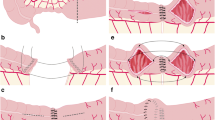Summary.
Patients with Crohn's disease are operated on with a morbidity of 15 % and a mortality of 0 % if the indication for surgery is decided in good time. After ileocecal resection the probability of having a second resection in 15–20 years is about 50 %. When elective surgery is done at an early disease stage, ileocecal resections and reoperations for anastomotic stenosis can be performed by assisted laparoscopy assisted. Laparoscopic colonic resections are done more rarely. Acute and life-threatening conditions such as obstruction, perforation and sepsis are excluded from the laparoscopic approach. In a combined series of 222 laparoscopic resections for Crohn's disease, the following types of surgery were included: ileocecal resections (75), anastomotic resections (26), small intestinal resections (4), loop ileostomies (17), gastrojejunostomies (3), partial colonic resections (15), colectomies (16), loop colostomies (2) and one adhesiolysis. Two patients who sustained intraoperative bleeding underwent conversion of laparotomy. The conversion rate ranged from 0 to 22 %. Reasons for 32 conversions were: large inflammatory mass (14), severe inflammation (5), fistula (3), abscess (1), perforation (1), small intestine dilation (1) and mesenteric thickening (1). Mean operative time for ileocecal resections ranged from 105 to 200 min. The postoperative hospital stay was 5 to 8 days. As more experience is gained and technical improvement is achieved, additional procedures such as resolution of severe adhesions, fistula closure and resections of colonic segments will be offered to the majority of patients who require elective surgery for localized Crohn's disease.
Zusammenfassung.
Bei rechtzeitiger Indikationsstellung können Patienten mit Morbus Crohn mit einer Morbiditätsrate von 15 % und einer Letalität von 0 % operiert werden. Bei der häufigsten Operation, der Ileocöcalresektion, muß mit einer Wahrscheinlichkeit von 50 % nach 15–20 Jahren ein Anastomosenrezidiv nachreseziert werden. Da der Operationszeitpunkt heute vor dem Eintritt schwerer septischer Komplikationen liegt, können Ileocöcalresektionen und Reoperationen wegen eines Anastomosenrezidivs laparoskopisch assistiert durchgeführt werden. Laparoskopische Colonresektionen sind bisher seltener. Akut lebensbedrohende Zustände wie die Obstruktion, Sepsis und Perforation werden für das laparoskopische Vorgehen ausgeschlossen. In einer Zusammenstellung von 222 laparoskopisch operierten Patienten mit Morbus Crohn sind folgende Operationstypen enthalten: 75 Ileocöcalresektionen, 26 Anastomosenresektionen nach ICR, 4 Dünndarmresektionen, 17 Loopileostomien, 3 Gastrojejunostomien, 15 Colonteilresektionen, 16 Colektomien, 2 Loopcolostomien und eine Adhäsiolyse. Intraoperative Komplikationen waren 2 Blutungen, die zur Konversion zwangen. Die Konversionsrate reicht von 0–22 %. Bei 14 von 32 Patienten war der Konversionsgrund ein nicht auflösbares Konglomerat, bei 5 Patienten die hochgradige Entzündung, bei 4 Patienten vorausgegangene Operationen, bei 3 Patienten eine Fistel. Bei jeweils einem Patienten mußte die Operation wegen eines Abscesses, einer Perforation, der Dünndarmdilatation und der Verdickung des Mesenteriums offen fortgesetzt werden. Bei Ileocöcalresektionen (ICR) reicht die durchschnittliche Operationszeit von 105–200 min. Der stationäre Aufenthalt beträgt nach der ICR 5–8 Tage. Mit dem Zugewinn an Erfahrung und der technischen Weiterentwicklung werden nicht nur unkomplizierte Ileocöcaloperationen, sondern auch komplexere Aufgaben wie die Auflösung von entzündlichen Adhäsionen, der Verschluß von Fistelverbindungen und die Resektion kürzerer oder längerer Dickdarmsegmente in zunehmendem Maß durchführbar. Von diesem Vorgehen werden die jungen Crohn-Patienten profitieren, die mit hoher Wahrscheinlichkeit mehrmals in ihrem Leben operiert werden müssen.
Similar content being viewed by others
Author information
Authors and Affiliations
Rights and permissions
About this article
Cite this article
Hildebrandt, U., Ecker, K. & Feifel, G. Minimal-invasive Chirurgie und Morbus Crohn. Chirurg 69, 915–921 (1998). https://doi.org/10.1007/s001040050513
Issue Date:
DOI: https://doi.org/10.1007/s001040050513




